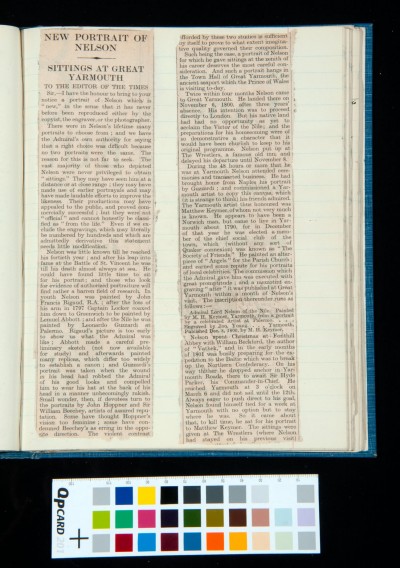Cotmania. Vol. VI. 1930-31
Archive: SDK Sydney Decimus Kitson Archive
Reference Number: SDK/1/2/1/6
Page:
-
Description
Letter by Geoffrey Callender on a New Portrait of Nelson: newspaper cutting
Two columns of type describing the Portrait of Nelson
Date: 1930-31
-
Transcription
NEW PORTRAIT OF
NELSON
SITTINGS AT GREAT
YARMOUTH
TO THE EDITOR OF THE TIMES
Sir,—I have the honour to bring to your
notice a portrait of Nelson which is
"new," in the sense that it has never
before been reproduced either by the
copyist, the engraver, or the photographer.
There were in Nelson's lifetime many
portraits to choose from ; and we have
the Admiral's own authority for saying
that a right choice was difficult because
no two portraits were the same. The
reason for this is not far to seek. The
vast majority of those who depicted
Nelson were never privileged to obtain
" sittings." They may have seen him at a
distance or at close range ; they may have
made use of earlier portrayals and may
have made laudable efforts to improve the
likeness. Their productions may have
appealed to the public, and proved com-
mercially successful ; but they were not
" official " and cannot honestly be classi-
fied as " from the life." Even if we ex-
clude the engravings, which may literally
be numbered by hundreds and which are
admittedly derivative this statement
needs little modification.
Nelson was little known till he reached
his fortieth year : and after his leap into
fame at the Battle of St. Vincent he was
till his death almost always at sea. He
could have found little time to sit
for his portrait; and those who look
for evidence of authorized portraiture
will find rather a barren field of research. In
youth Nelson was painted by John
Francis Rigaud, R.A. ; after the loss of
his arm in 1797 Captain Locker coaxed
him down to Greenwich to be painted by
Lemuel Abbott ; and after the Nile he was
painted by Leonardo Guzzardi at
Palermo. Rigaud's picture is too early
to show us what the Admiral was
like ; Abbott made a careful pre-
liminary sketch (not now available
for study) and afterwards painted
many replicas, which differ too widely
to establish a canon ; and Guzzardi's
portrait was taken when the wound
in his head had robbed the Admiral
of his good looks and compelled
him to wear his hat at the back of his
head in a manner unbecomingly rakish.
Small wonder, then, if devotees turn to
the portraits by John Hoppner and Sir
William Beechey, artists of assured repu-
tation. Some have thought Hoppner's
vision too feminine ; some have con-
demned Beechey's as erring in the oppo-
site direction. The violent contrast
afforded by those two studies is sufficient
by itself to prove to what extent imagina-
tive quality governed their composition.
Such being the case, a portrait of Nelson
for which he gave sittings at the zenith of
his career deserves the most careful con-
sideration. And such a portrait hangs in
the Town Hall of Great Yarmouth, the
ancient seaport which the Prince of Wales
is visiting to-day.
Twice within four months Nelson came
to Great Yarmouth. He landed there on
November 6, 1800. after three years'
absence. His intention was to proceed
directly to London. But his native land
had had no opportunity as yet to
acclaim the Victor of the Nile; and the
preparations for his homecoming were of
so demonstrative a character that it
would have been churlish to keep to his
original programme. Nelson put up at
The Wrestlers, a famous old inn, and
delayed his departure until November 8.
During the 48 hours or more that he
was at Yarmouth Nelson attended cere-
monies and transacted business. He had
brought home from Naples his portrait
by Guzzardi ; and commissioned a Yar-
mouth artist to copy this canvas, which
(it is strange to think) his friends admired.
The Yarmouth artist thus honoured was
Matthew Keymer,ofwhom not very much
is known. He appears to have been a
Norwich man, but came to live in Yar-
mouth about 1790, for in December
of that year he was elected a mem-
ber of the chief social club of the
town, which (without any sort of
Quaker connexion) was known as "The
Society of Friends." He painted an altar-
piece of "Angels " for the Parish Church :
and earned some repute for his portraits
of local celebrities. The commission which
the Admiral gave him was executed with
great promptitude ; and a mezzotint en-
graving " after " it was published at Great
Yarmouth within a month of Nelson's
visit. The inscription thereunder runs as
follows : —
Admiral Lord Nelson of the Nile. Painted
by M.H. Keymer, Yarmouth, from a portrait
by a celebrated Artist at Palermo. . .
Engraved by Jno. Young. . . Yarmouth.
Published Dec. 8, 1800, by M.H. Keymer.
Nelson spent Christmas at Fonthill
Abbey with William Beck ford, the author
of " Vathek," and in the early months
of 1801 was busily preparing for the ex-
pedition to the Baltic which was to break
up the Northern Confederacy. On his
way thither he dropped anchor in Yar-
mouth Roads, there to await Sir Hyde
Parker, his Commander-in-Chief. He
reached Yarmouth at 3 o'clock on
March 6 and did not sail until the 12th.
Always eager to push direct to his goal,
Nelson found himself tied for a week at
Yarmouth with no option but to stay
where he was. So it came about
that, to kill time, he sat for his portrait
to Matthew Keymer. The sittings were
given at The Wrestlers (where Nelson
had stayed on his previous visit)
